Get ready to create your own self-sustaining indoor garden with these gorgeous DIY self-watering planters! In this post, I’ll show you how to transform simple glass globes and vases into beautiful, functional self-watering planters. These planters are inspired by the coveted Ballard Designs style and use a clever wick system that delivers water directly to the roots. With just a few affordable supplies, you can craft a customized self-watering planter that is both lovely and low maintenance. I’ll guide you through each step and share tips to keep your plants healthy and happy in their new hydration station. Whether you’re a busy plant-parent or struggle with overwatering, these DIY self-watering planters are about to become your new green thumb secret weapon!

*This post on DIY Self watering planters includes affiliate links, for more info on affiliate links visit here.
What is a Self Watering Planter?
Alright, before we dive any deeper, let’s break down what a self-watering planter actually is. These planters we’re talking about come with a clever self-watering setup. Imagine a special wick that acts as nature’s straw – it pulls water up from a reservoir below and delivers it right to your plant’s roots. This planter sits on top of another container, which holds the water supply, and the wick bridges the gap between them. So, it’s basically like your plant’s own personal hydration system.

The Science Behind Self Watering Planters
Capillary Action Explained
Now, here’s the science bit: self watering planters do their magic through capillary action or wicking. This process relies on capillary rise in the soil, which is the ability of water to flow upward through porous spaces. It occurs due to the adhesive forces between water molecules and the soil particles.
As your plant absorbs water from the soil, it creates spaces for air in the soil pores. This leads to lower water pressure in the soil compared to the water reservoir below. The adhesive forces then pull the water molecules up through the soil to fill these pores.
According to this article on Tumbleweed.com, “Capillary rise is a function of the size of the soil particles. Most well-structured, friable soils can achieve a capillary rise of around 35cms.” (which is about 14 inches) – This allows the water to be lifted up from the reservoir through the wick and soil to the plant roots where it is needed.
As your plant slurps up water, the soil wicks up more, maintaining a steady level of moisture in the soil. This automated, self-sustaining process powered by capillary action is what makes self-watering planters so efficient. Pretty cool, right?
Benefits of the Self Watering System
The best part? This setup significantly slashes the risk of overwatering, which can often lead to root rot and make you question your green thumb status. It’s like a lifesaver for those of us who tend to get a bit carried away with the watering can. Plus, it’s a total game-changer for jet-setters who aren’t always around to water their leafy buddies.
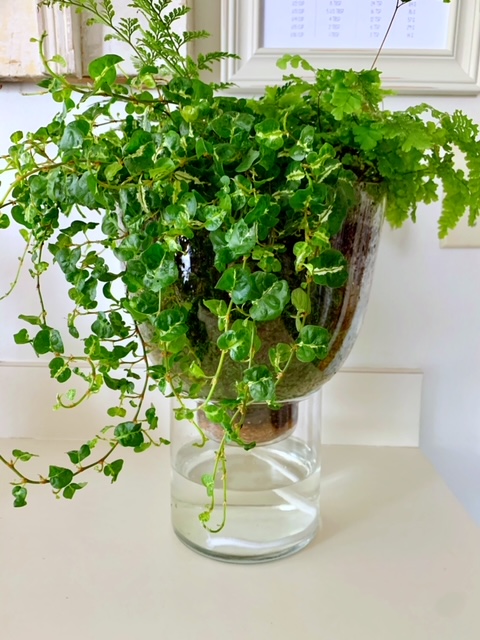
About the Design
When I started researching self-watering planter systems, I struggled to find one that I’d display in my office window. I wanted something that not only worked well but also added a touch of beauty to my home decor. But everywhere I looked, it seemed like the options were less than appealing (seriously, who wants an upside-down 2-liter bottle of Pepsi in their office?). I mean, plants are meant to enhance our spaces, right? So, the thought of cutting up plastic soda bottles and calling them self-watering planters just didn’t sit right with me. I was determined to find a solution that was both functional and visually appealing. Let me tell you, it took some digging, but I finally discovered a way to create self-watering planters that are actually pretty!
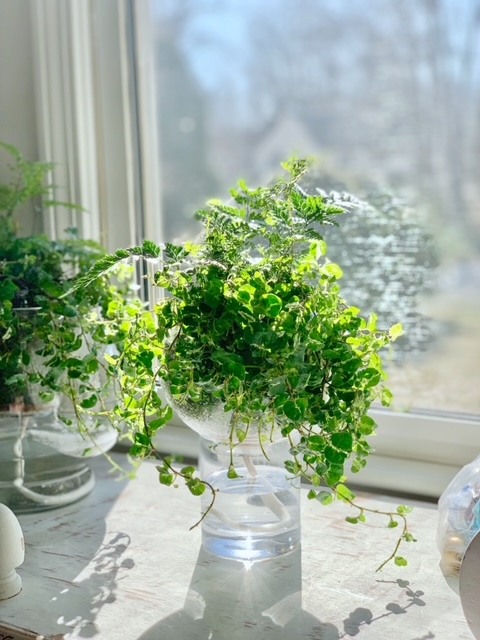
10 Reasons to Love this Project:
- Easy Maintenance: Once set up, these self-watering planters require minimal effort to maintain. The built-in watering system provides a consistent water supply, reducing the need for frequent watering and the risk of overwatering.
- Healthier Plants: The self-watering system promotes healthier plant growth by ensuring plants receive the right amount of water and nutrients. This leads to stronger roots, lush foliage, and vibrant blooms. You’ll see!
- Time and Water Saving: With the self-watering feature, you can save time and water by reducing the need for daily watering. The system efficiently delivers water directly to the roots, minimizing water waste and the hassle of manual watering.
- Versatility: These DIY glass globe self-watering planters offer endless possibilities for creativity and personalization. You can choose different glass globes, vases, and plants to match your style and decor, making it a fun and customizable project.
- Ideal for Busy Individuals: If you have a busy schedule or often travel, these self-watering planters are perfect for you. They provide a self-sustaining watering solution, ensuring your plants stay hydrated even when you’re away.
- Decorative Appeal: These planters not only serve a practical purpose but also add aesthetic value to your indoor space. The glass globes create an elegant and visually appealing display, enhancing the beauty of your plants and home decor.
- Successful Plant Care: For those who may feel they lack a green thumb, these self-watering planters offer a higher chance of success. The consistent moisture levels and reduced risk of overwatering help plants thrive, boosting your confidence as a plant parent. You can do this!
- Educational and Engaging: Engaging in DIY projects like these self-watering planters can be a fun and educational experience. You can learn about plant care, water management, and enhance your gardening skills while enjoying the process.
- Eco-Friendly Option: By utilizing self-watering systems, you contribute to water conservation efforts by using water more efficiently. Additionally, growing indoor plants helps purify the air and create a healthier living environment.
- Satisfaction of Growing Your Own Plants: Finally, one of the most rewarding aspects of this project is the joy of watching your plants flourish. The sense of accomplishment and fulfillment derived from growing and caring for your own indoor garden is truly priceless!
Glass Globes as Planters
Now back to the design. As I set out to find a way to make my own “pretty” self-watering planters my research brought me to these glass planters from Ballard Designs. These planters are in a word, beautiful! They are also quite pricey so I knew finding a cheaper option was in order. We don’t often think about glass for planters but these were simply stunning so I knew I wanted to work with glass as the medium. As I considered options I knew I needed a glass container with a large opening (for the plants) and a smaller opening on the bottom (for the watering system). I eventually came up with a great idea to use glass globes (from light fixtures) as they have both a large opening and a smaller one. Lowes carries several types of replacement globes so I started there. I bought 3 different sizes that were different shapes – and just like that my plan to transform these light fixture globes into planters was underway.
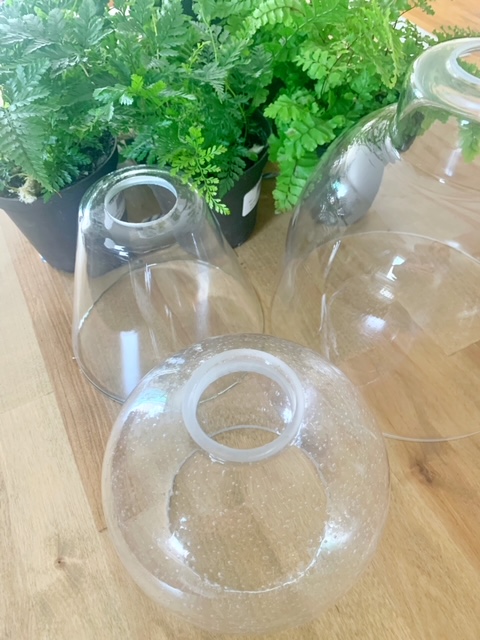
Glass Vases for the Water Reservoir
Next, I needed to figure out what to use for the bottom of the planter where the water reservoir would be. I decided to check my storage unit for used glass vases and found 3 that would work. Here are the globes with their corresponding vases before planting.
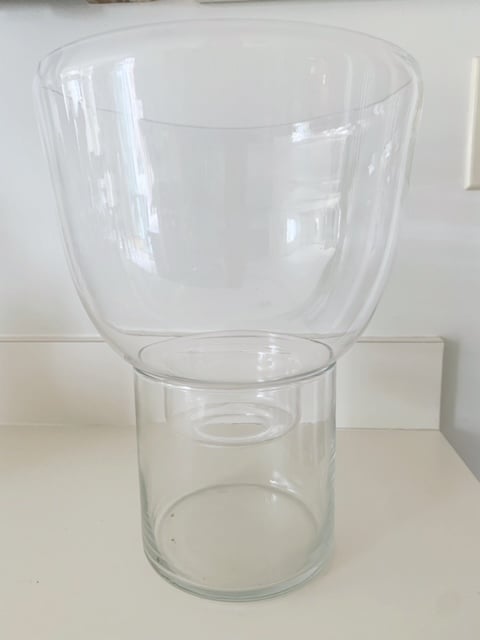

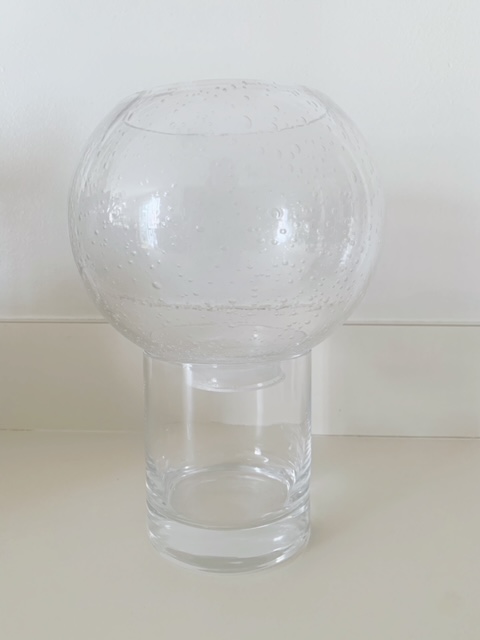
Supplies for this Project
- 3 Glass lighting globes (linking 1 style)
- 3 glass vases (linking 1 style)
- Self-watering wick
- Coco liner
- Sheet moss
- Potting soil
- Plants
Tools Required for this Project
- Hand shovel
- Scissors
- Container (to be filled with water to soak the moss)
- Watering can
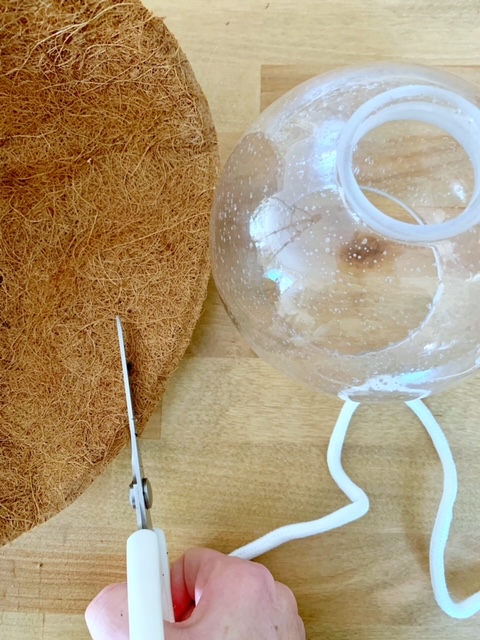
How to Make a Pretty Indoor DIY Self Watering Planter
- First, cut a circle out of the coco liner that is a bit larger than the small opening of the lighting globe. With scissors cut a small hole in the middle of the coco liner circle. Feed the wick through the hole leaving approx 6″ hanging below and 6″ on the top. Tie a knot right above the hole in the coco liner piece then fit this piece into the globe. Sit the globe on the bottom of the planter. (vase)
- Soak the moss in water. Then take sections of the moss and line the globe. The moss is more decorative than seeing the soil through the glass.
- Add some potting mix to the bottom just above the coco liner circle and water for moist soil.
- Remove each plant from its plastic pot and plant in the globe. Be sure to work the wick up in and around the plant roots so they get enough water.
- Fill the vase with a good amount of water and place the planted globe in the opening with the wick hanging and touching the water.
Printable Step-by-step Directions
How to DIY an Indoor DIY Self Watering Planter (Ballard Designs style) Step-by-step instructions
Equipment
- 1 Hand shovel
- 1 Pair of scissors
- 1 Container of water
- 1 Watering can of water
Materials
- 3 piece Glass globes (with opening on the bottom)
- 3 piece Vases to hold the glass globes
- 1 Pkg Self watering capillary wick cord
- 2 pkg Green moss
- 1 bag Potting soil
- 1 piece Cocoa liner
- 3-4 pots Assorted potted plants
Instructions
- Fill a container (or sink) with water and soak the moss.
- Gather your supplies for setting up the wicking system. This includes the glass globe, the wick and a coco liner.
- Using scissors cut a circle from the coco liner. This circle should be a bit bigger than the opening of the small hole in the glass globe.
- Fold the circle in half and with scissors cut a small hole in the center for the wick to feed through. Feed the wick through the hole leaving approximately 6" above the coco circle and 6" below.
- Tie a knot in the wick right above the hole. This will help keep the potting soil from falling through. Place the coco circle/wick on the bottom (small hole) of the globe planter. The knot should be in the planter, the bottom of the wick hanging through the small hole of the globe. (this part will sit in the water reservoir)
- Coil the wick in the center of the globe to prepare for the moss.
- Take small sections of the wet moss and squeeze the extra water from them. Place the moss around the inside of the globe building up the sides until you reach the top. The moss is more decorative than seeing the soil through the glass.
- While applying the moss leave the center open for the plantings.
- Place a small amount (approx 1 cup) of potting soil to the bottom of the globe. Keep the wick from getting buried. Add water to moisten the dry potting soil.
- Take the first plant and remove it from the plastic pot it came in. Place the plant in the globe pressing to one side so you can fit another plant in next to it.
- Continue until all plants are planted. Note: you may need to shake some of the excess soil form the plants to fit it in the globe.
- Fill the base with fresh water and place the globe with the wick hanging in the glass. The wick should come in contact with the water, the planter should sit at the top.
- You're done! Place the plant where it can get plenty of sunlight and periodically check the level of the water reservoir. Add more water as needed.
Tips for Choosing Plants and Where to Buy
Choosing the right indoor plants: For this project, I decided to go with 2 types of ferns and a plant Ficus Pumila (Creeping Fig Plant) that was in a plastic hanging planter. I wanted the plants in the glass planters to have a hanging effect so these small trailing delicate vines would accomplish that and the ferns add a nice texture to the assembly of house plants. For a list of plants that are known to do well in self-watering containers please visit this list from Mind Plants, they have you covered!
Tip: Choose smaller, more delicate plants for these dainty glass planters. This will help maintain the aesthetic balance and ensure the plants have enough space to thrive comfortably.
Where to buy Plants: I bought these plants at Lowes while I was shopping for the lighting globes that way I could estimate how many I would need for this project. Plants typically come in plastic pots and are available at garden centers, grocery stores, and larger home improvement stores.
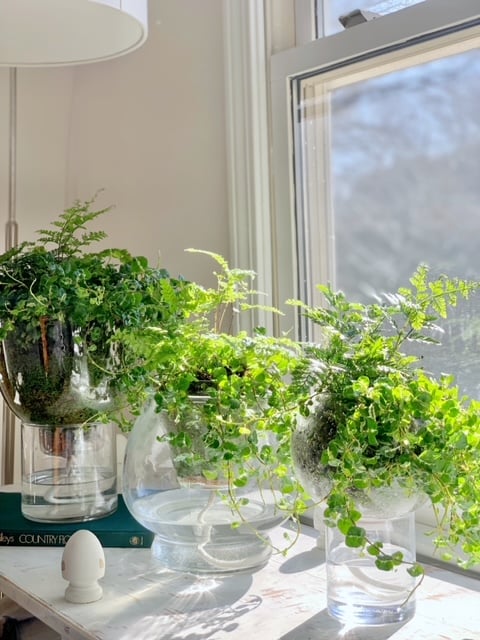
Variations and Special Considerations
Various materials: My research revealed many different materials that could be used to make DIY self-watering planters. You can use PVC pipe cut into sections, or plastic bottles cut in 1/2 (the spout is inverted and holds the wick, and the bottom of the bottle holds the well of water.) You can also sit in a traditional plastic container the plant comes in and works a wick through the drainage holes. Then place the pot on a cup of water or another water-holding vessel.
String options: One article I read indicated that you could use a regular cotton string. I decided to go with a self-watering wick that is specially made for this purpose as it is proven to work and is not very expensive.
Herbs: This setup would make a great kitchen herb garden. Most herbs would do well with this watering system as they require a lot of moisture. Picture a windowsill with several self-watering containers holding basil, thyme, rosemary, and cilantro. Beautiful!
Vegetables: My research also brought me to several outdoor vegetable garden setups. Most included tomato plants in a system for 5-gallon buckets. According to Mind Plants list cherry tomato plants do particularly well with this system.

Caring for Your Self Watering Planters
Sunlight:
Optimal Lighting – Position your self-watering planters in a location that provides plenty of indirect sunlight each day. Avoid placing them near drafty windows to prevent temperature fluctuations that can affect plant health. For instance, my planters have thrived in my office, enjoying the gentle afternoon sun that filters in.
Water level:
Soil Moisture vs. Surface Dryness – Be mindful of the water level in the base container. While the soil surface may occasionally feel dry to the touch, the soil around the plant roots should remain consistently moist. Avoid letting the water level in the reservoir run too low to ensure your plants receive an adequate water supply.
Wick adjustments:
Fine-tuning Water Uptake – The wick is your tool for controlling the water flow to your plants. If you notice your plants need more hydration, you can gently unravel the bottom of the wick to allow for increased water absorption. Conversely, if you find that your plants are getting too much water, consider tying a knot in the wick. This simple adjustment can slow down the rate of water uptake, providing your plants with the right amount of moisture.
Maintenance of the Water Reservoir:
Keeping It Clean – It’s essential to maintain the cleanliness of the water reservoir. Each time you refill the water container, take a moment to clean the glass vase thoroughly. This practice helps reduce the buildup of bacteria and algae, ensuring your plant’s water source remains fresh and clear. Regular maintenance contributes to the overall health of your self-watering planters and the longevity of your plants.

Frequently Asked Questions about Self Watering Planters
African violets, ferns, Philodendron/Pothos and many moisture-loving herbs and vegetables do well in this self-watering system.
Adding rocks to the bottom of the water reservoir vase or glass globe is not necessary for the functionality of the self-watering system. The rocks can be added solely for decorative purposes if desired. The self-watering system relies on the principles of gravity and capillary action, with the water being drawn up through the wicking material into the soil. So feel free to skip the rocks if you’re primarily focused on the functionality of the system.
Some plants like orchids and succulents prefer drier soil. These types of plants could potentially get root rot in a self-watering planter. It’s best to choose plants that prefer moist soil.
This system is intended to make plant care a breeze. Plant lovers who struggle to keep indoor plants alive often “over-care” for them by giving them an excess of water. Too much water and your plants are doomed! This system lets the plant decide how much water it needs taking the guesswork out of – to water plants or not.
The frequency of refilling the water depends on factors such as the size of the globe, the plant’s water needs, and environmental conditions. Check the water level regularly and refill as needed. It’s essential to maintain a steady supply of water without allowing the globe to run completely dry.
Monitoring the plant’s health and observing its growth can indicate whether it is receiving the right amount of water. If the plant appears healthy, with vibrant foliage and growth, and the soil feels moist but not overly saturated, it is likely receiving an adequate water supply. Adjust the water level if necessary based on these observations and your specific plant’s watering needs.
Yes, you can definitely plant flowering plants in your self-watering planter. Many flowering plants can thrive in self-watering systems and benefit from the consistent water from the wick system in the water reservoir chamber. Here are a few popular flowering plant options that can be suitable for self-watering planters: Kalanchoe, African violets, Orchids, Cyclamen, Gloxinia, Christmas cactus, and Peace lilies. (Below are three African Violets and a spider plant in glass globe self-watering planter)
For your self-watering planter, it’s best to use a well-draining potting mix specifically designed for container gardening. Look for a high-quality potting mix that contains moisture-retaining additives like vermiculite or perlite. These additives help retain moisture while allowing excess water to drain away. Incorporating organic matter such as compost or coconut coir can further improve water retention and nutrient content.
Fertilizing plants in self-watering planters can be beneficial for their overall health and growth. It’s essential to use a diluted, water-soluble fertilizer mixed with the reservoir water to ensure a gradual and consistent nutrient supply. However, monitor your plants’ specific needs and growth, avoiding over-fertilization to prevent nutrient buildup that could harm the plants. Visit my Indoor Plant Fertilizers You Can Make at Home (Feed Your Plants the Natural Way to learn how to make your own.

After following along on this DIY self-watering planter journey, you now have the knowledge to create your own beautiful, functional hydration stations! We covered the benefits of self-watering systems – healthier plants, reduced maintenance, and built-in water conservation. You learned how to transform inexpensive glass globes and vases into gorgeous planters using an easy wick setup. Just choose moisture-loving plants, maintain proper water levels, and occasionally adjust the wick as needed. With the step-by-step instructions provided, you can craft customized self-watering planters to match your decor and plants’ needs.
Get creative with different globe styles, vase shapes, and plant varieties for an endless array of possibilities. I hope you feel empowered to build your own self-sustaining indoor garden. This simple DIY project leads to happy, thriving plants that practically care for themselves! If you have any other questions, feel free to ask in the comments. I invite you to explore more DIY ideas here on the blog and we are always chatting about plant design and plant care here at the nest! Now go cultivate your very own beautiful, worry-free oasis!
Thank you for stopping by to read DIY Indoor Self Watering Planters (Ballard Designs style). You know I’m always up for a DIY plant project and this self-watering system is a great way to have beautiful lush plants that can essentially take care of themselves!
For more planter and container garden ideas please visit my grapevine wreath topiary and my lightening bug succulent project!
Keep creating friends!



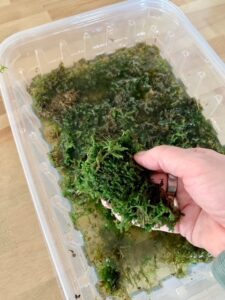
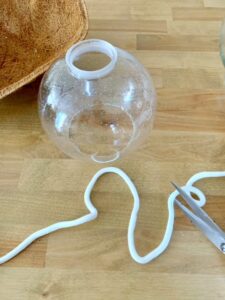

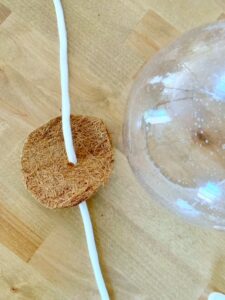
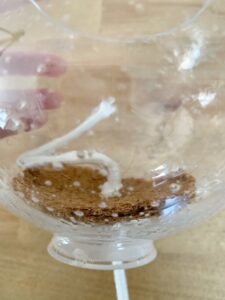
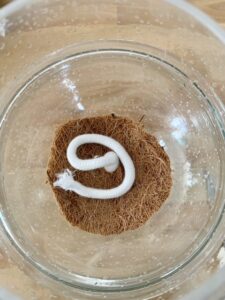

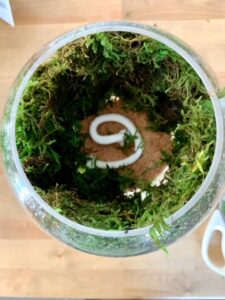
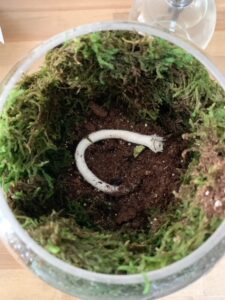
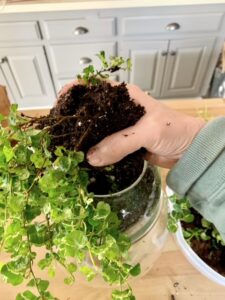
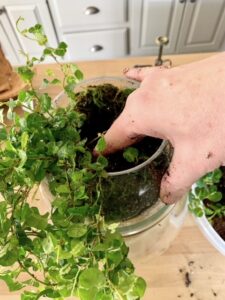
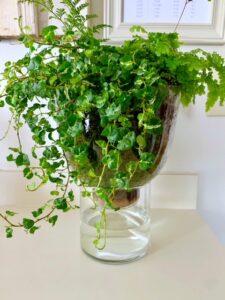
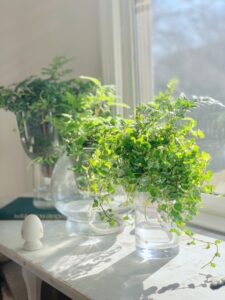


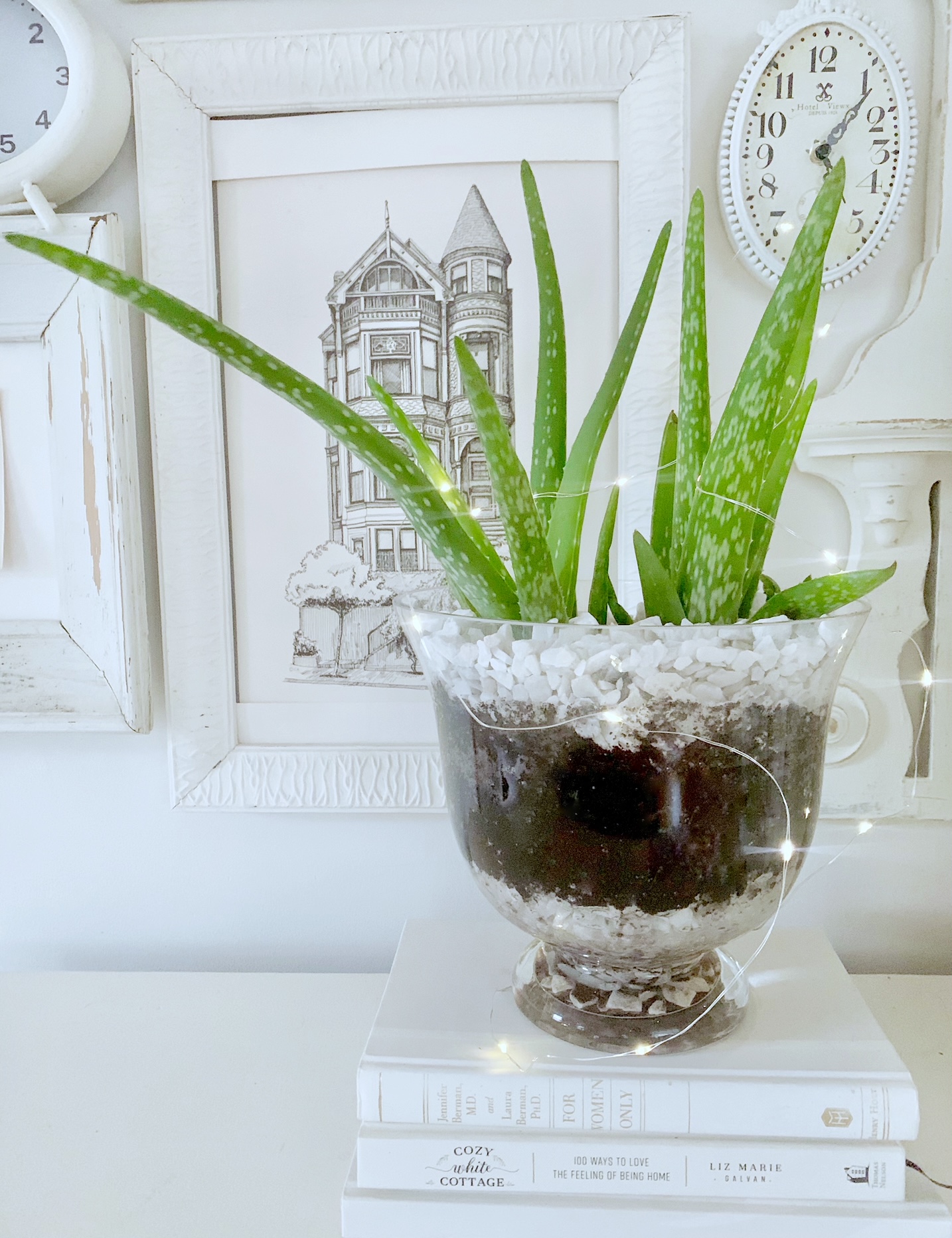
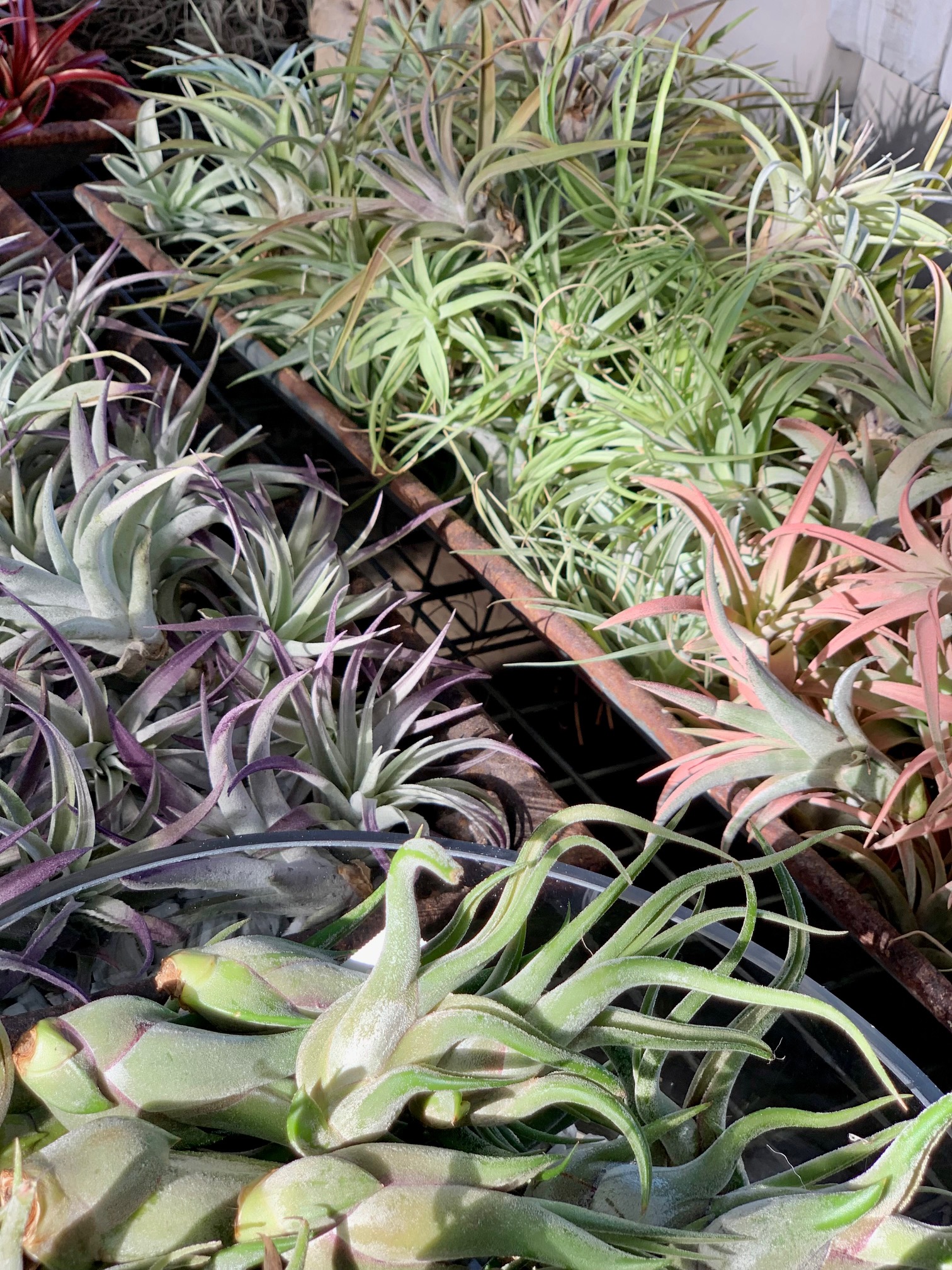



Such an amazing idea!!! I did purchase the small self watering planter from Ballard designs at a great discount…. Before I saw your blog. I’m just wondering how you plants have been getting on over the year. I’m off to go find some glass lampshades now 😉
Thank you Monique!
My plants did really, really well! This summer I moved them to larger pots to give their roots more space!
Hello! Can I use Leca or lava rocks instead of regular soil for this?
Good question! I don’t believe so because the wicking system draws water to the soil. the soil then holds the water for the plants.
Thank you! Really great idea and looks so pretty!
Thank you Suzanne!
Love this idea. Thank you for sharing and the step by steps! Diffinetly doing.
Thank you for vising the blog!
Definitely going to try this! Thanks for the step by step!
Thank you Diane!